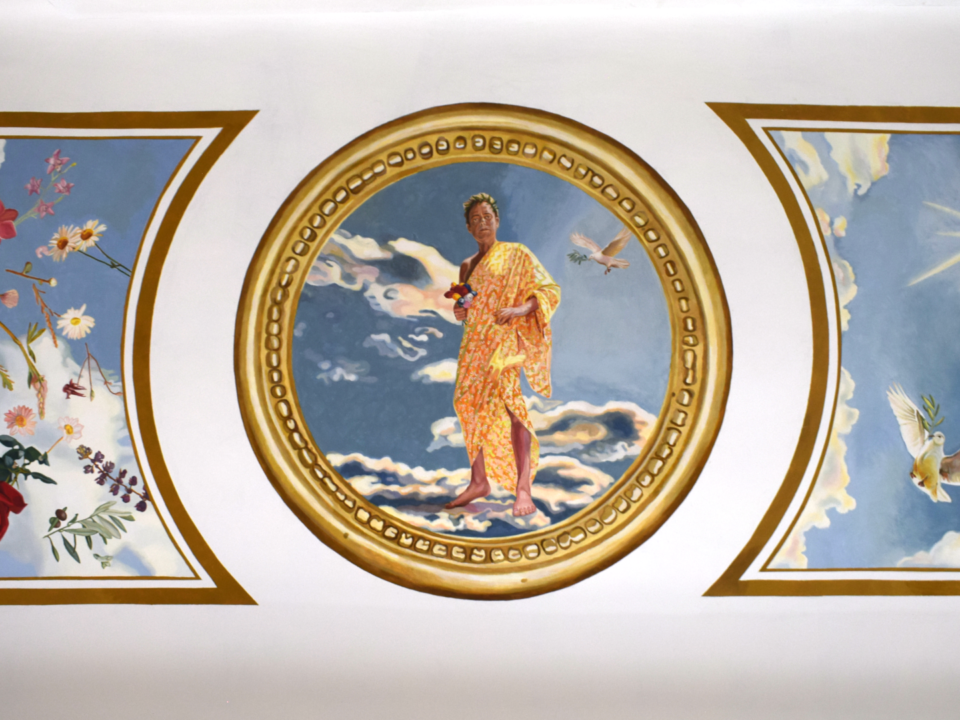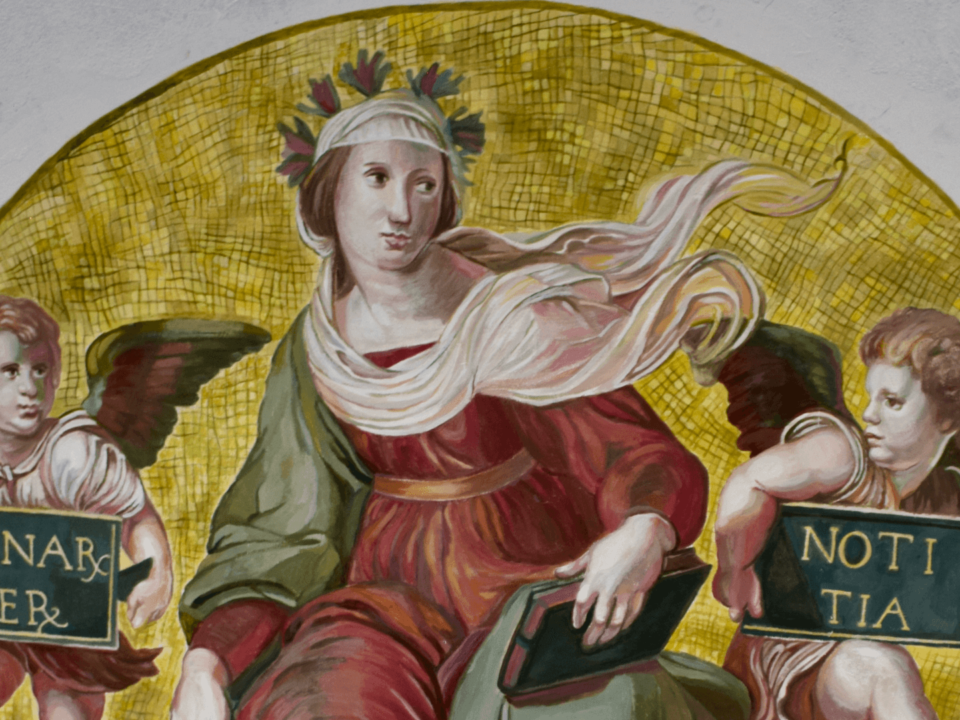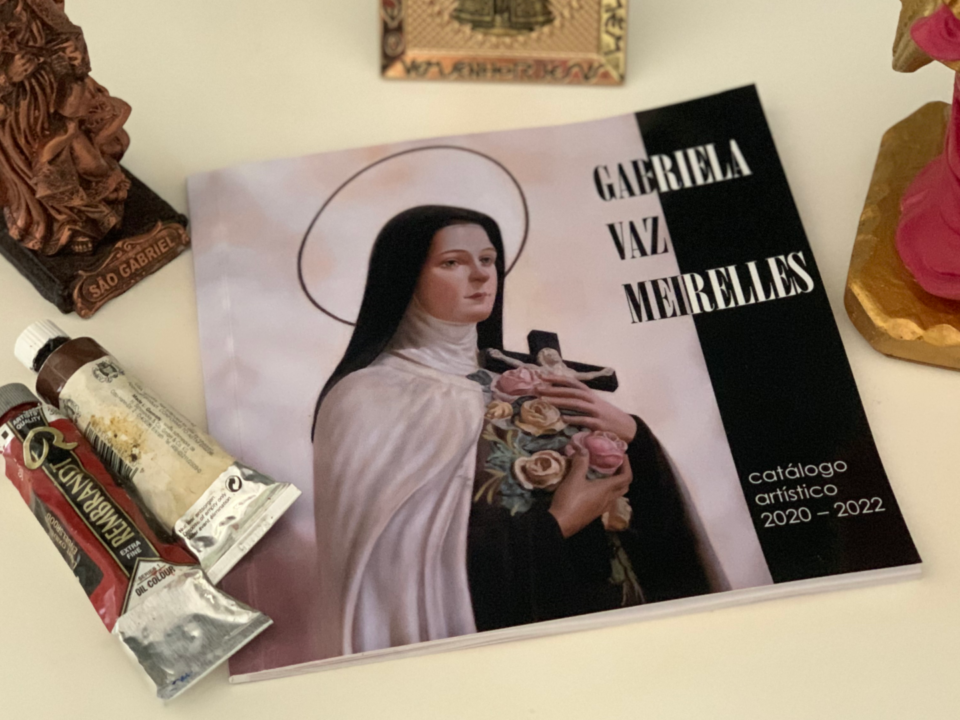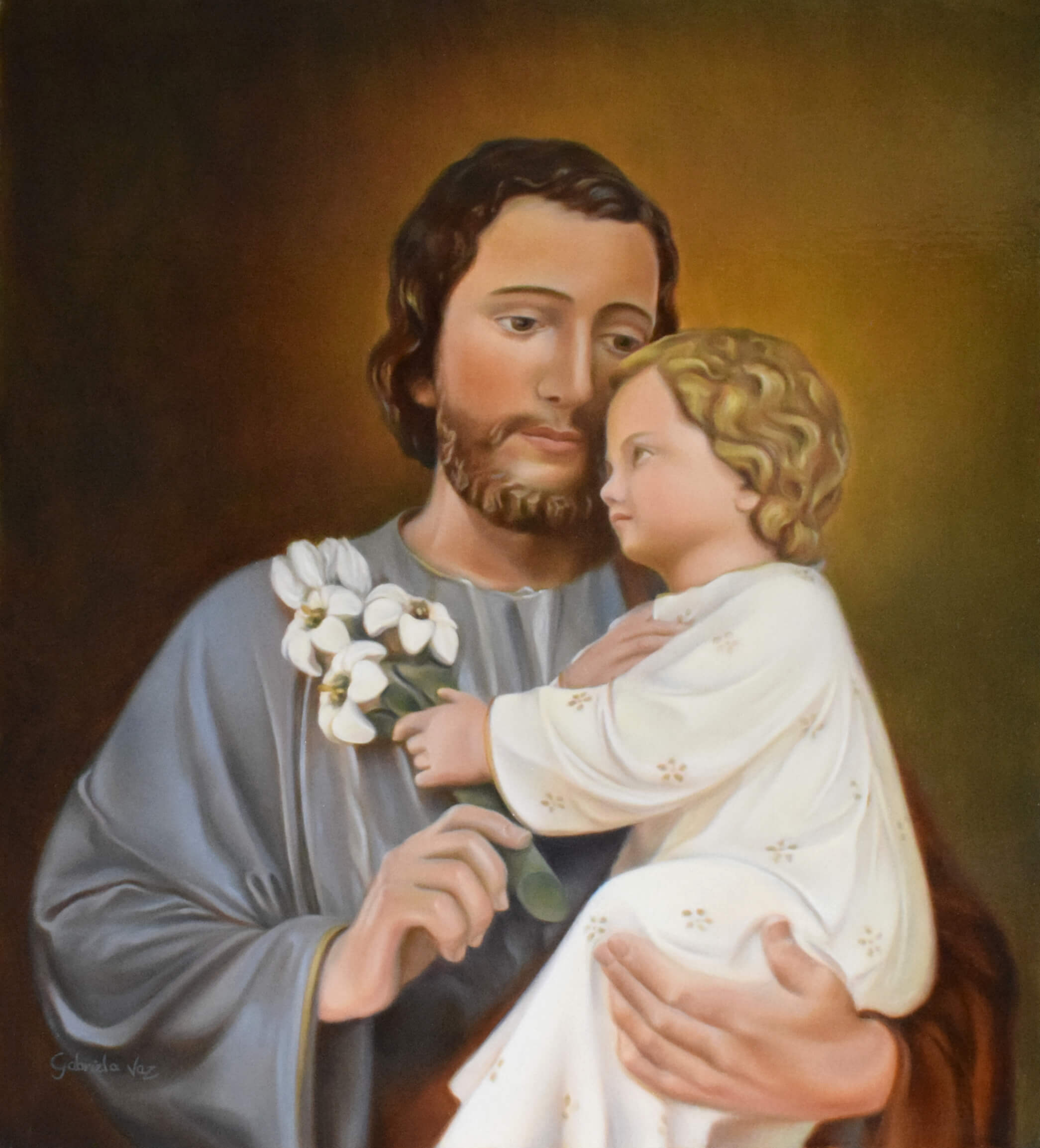
Gabriela Vaz Meirelles, Saint Joseph with the Child Jesus, oil on linen, 55 x 50 cm, 2021
History Background
According to the canonical Gospels, Joseph was a first-century Jewish man from Nazareth, descended from the royal house of David, married to the Virgin Mary, the mother of Jesus, and the adoptive father of Jesus.
The epistles of Paul are the oldest known Christian writings. These mention Jesus' mother, without naming her, but do not refer to his father. Mark's Gospel does not mention Jesus' father either. The first appearance of Joseph is in the gospels of Matthew and Luke. Each contains a genealogy of Jesus showing his ancestry from King David but through different sons. Matthew follows the main royal line to Solomon, while Luke traces another line back to Nathan, another son of David.
The childhood narratives also appear only in Matthew and Luke. In Matthew, Joseph was engaged to Mary and, upon learning that she was pregnant, he thought of leaving her, so that she would not be punished by stoning, since the child was not his. But he had a dream of an angel who told him that Mary became pregnant by the action of the Holy Spirit, and that the boy who was to be born was the Son of God, so he accepted Mary as his wife.
After Jesus' birth in Bethlehem, an angel tells Joseph in a dream to take his family to Egypt to escape the massacre of the children of Bethlehem planned by Herod, the ruler of the Roman province of Judah. After Herod died, an angel told Joseph to return to Nazareth with Mary and Jesus, but to avoid Herod's son, and so he did.
Joseph's story resonates very much with the Old Testament heritage. An evil ruler wanted to kill the young Savior because he saw him as a threat. Pharaoh had ordered the deaths of Hebrew boys long ago in Egypt, and now a wicked king like him reigned in Jerusalem. Herod massacred the young boys in and around Bethlehem when he realized that the magi had deceived him. In Exodus, the Hebrews had fled Egypt on the night of the Passover. Now the young Messiah flees Israel to go to Egypt at night. After the danger was over, Joseph brought the family back to the Promised Land, just as the Hebrews finally returned after wandering in the desert for forty years. There is also the story in Genesis of another Joseph, who unwittingly went to Egypt as a slave, but ended up saving his entire family from famine by bringing them there. These connections are certainly not accidental, for the gospel of Matthew depicts Joseph's role in the Lord's infancy with obvious Old Testament symbolism. Joseph's story is a challenging reminder that God calls us to cooperate with His gracious purposes to bring salvation to the world. We do not serve Him in a realm of imaginary perfection any more than Joseph did, but in the same world with children whose lives are in danger of deadly violence and with families who must flee for their lives as refugees. There are still many rulers and regimes as evil as Herod today.

The Virgin and Child Surrounded by the Holy Innocents, Peter Paul Rubens (1616, Louvre Museum)
In the Gospel book of Luke, Joseph already lives in Nazareth, and Jesus is born in Bethlehem, because Joseph and Mary needed to travel there to be counted in a census. Luke's account does not mention the visit of angels to Joseph, the Massacre of the Innocents or a visit to Egypt, but it narrates the presentation of the baby Jesus to the Lord in the Temple of Jerusalem, as it was written in the Law.
The last time Joseph appears in person in any of the canonical Gospels is in the narrative of the visit to the Temple of Jerusalem for the Passover festivities when Jesus was 12 years old, which is found only in Luke. After the feast days, while returning home, Jesus stayed in the Holy City, without Joseph and Mary noticing. After searching for him for three days among the crowd of pilgrims, they finally found him in the temple, discussing the Scriptures with the doctors of the Law. According to Luke, his mother scolded him, explaining how she and her husband were worried about him. Jesus, in turn, talked to his parents about being in his "Father's" house, which means God. However, even though he was aware that Joseph was not his biological father, the teenager Jesus respected him like a real son. This story emphasizes Jesus' awareness of his coming mission.
The New Testament does not mention Joseph's death, but he is never mentioned after Jesus' childhood, and Mary is always shown alone, often dressed as a widow in other texts and artworks covering the period of the ministry and the Passion of Jesus. If he had been present at the crucifixion, in Jewish custom, he would be expected to take charge of Jesus' body, but this role is performed by Joseph of Arimathea. Nor would Jesus have entrusted his mother to the care of John the Apostle if her husband was alive.
In contrast, the apocryphal story of Joseph the Carpenter, from the 5th or 6th century, referred to as a biography of Joseph dictated by Jesus, describes how 90-year-old Joseph, a widower with four sons and two daughters, is tasked with caring for 12-year-old Mary, who then lives in his house raising his youngest son James the Minor (the supposed author of the Protoevangelium) until she is ready to marry at 14 and a half. This narrative presents a long account of Joseph's peaceful death, aged 111, in the presence of Jesus, Mary and angels. This scene begins to appear in art in the 17th century.
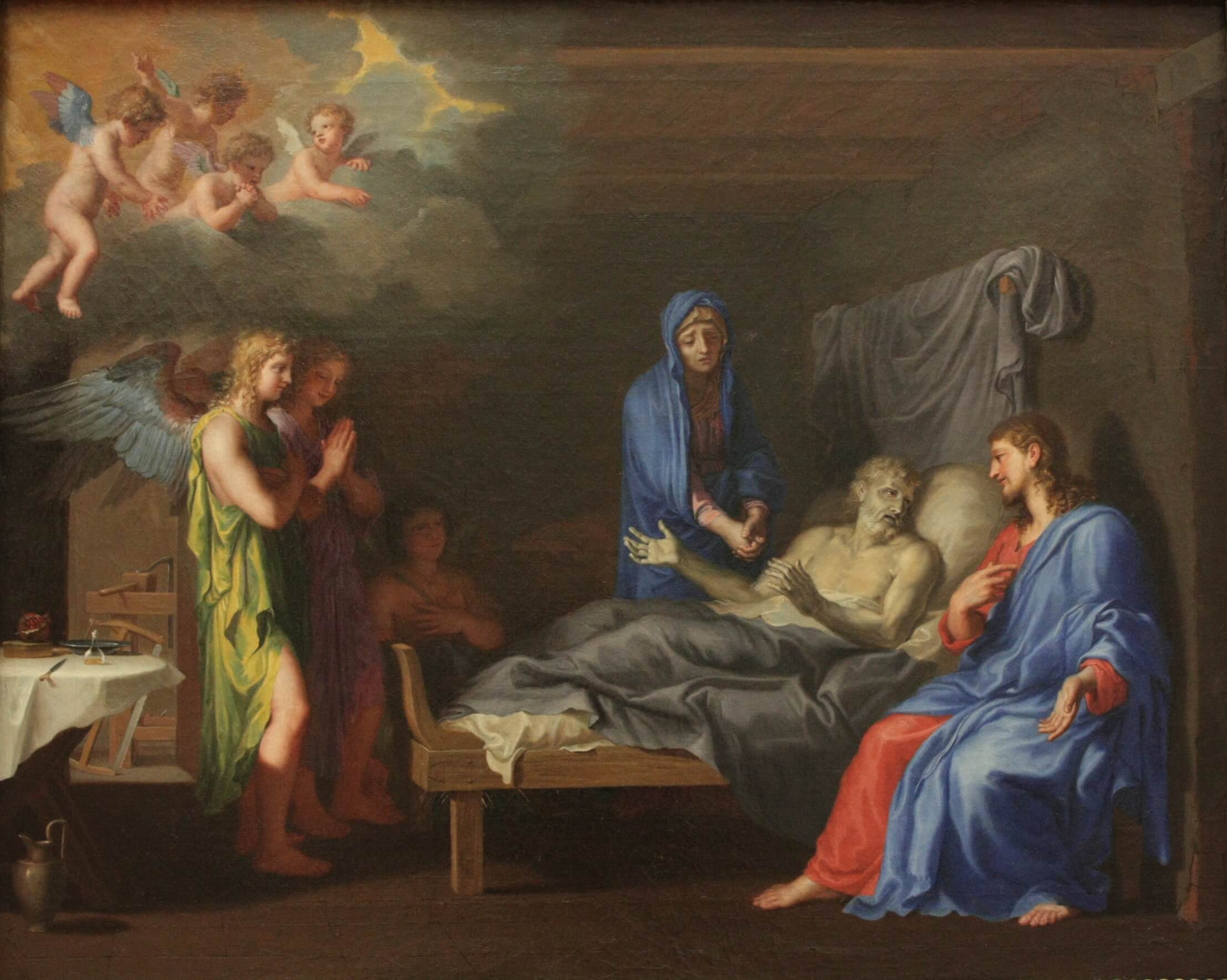
The death of Saint Joseph, Jacques Stella (Grenoble Museum)
Modern positions on the question of the relationship between Joseph and the Virgin Mary vary. The Eastern Orthodox Church claims that Joseph was a widower and betrothed to Mary, an elderly relative who reluctantly became her guardian when she had to leave the Temple where she grew up. The position of the Catholic Church, derived from the writings of St. Jerome from around 400 AD, is that Joseph was Mary's husband, but references to Jesus' "brothers" should be understood as cousins. This usage prevails throughout history and occurs in other parts of the Bible. Abraham's nephew Lot (Genesis 11:26-28) was referred to as his brother (Genesis 14:14), as was Jacob's uncle Laban (Genesis 29:15). Jesus himself often used the word "brother" as a generic term for one's fellow man. This custom has continued into modern times, with close friends, colleagues, and fellow churchgoers often referred to as "brothers and sisters". In the Gospels, Joseph's occupation is mentioned only once:
“Isn’t this the carpenter's son (ho tou tektōnos huios)?”.
MATTHEW 13:55
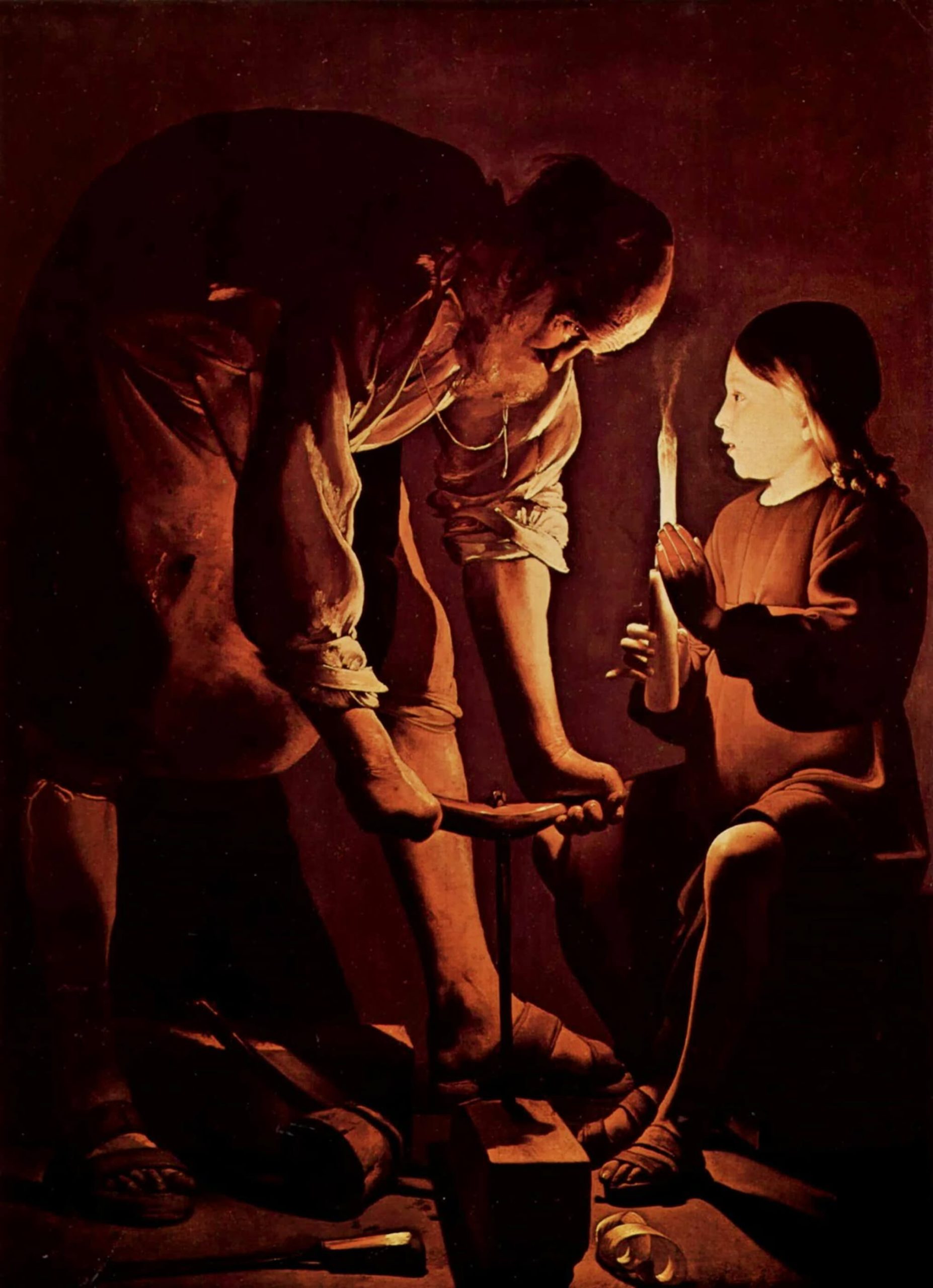
Joseph the Carpenter, Georges de La Tour (1645, Louvre Museum)
The description of Joseph as a "tekton" (τέκτων) was traditionally translated from the Greek as "carpenter", but it is a very general word (from the same root as the word "technician") that could cover makers of objects in several materials. The Greek term evokes an artisan in wood in general, or an artisan in iron or stone. But the specific association with woodworking is a constant in early Christian tradition. Other scholars have argued that "tekton" could equally mean a highly skilled artisan in wood or metal of greater prestige, perhaps running a workshop with several employees. The terms "carpenter" and "son of a carpenter" are also used in the Jewish Talmud to mean a very wise man, and he suggests that a description of Joseph as "naggar" (carpenter) could indicate that he was considered wise and highly literate in the Torah.
Saint Joseph Veneration
The first records of a formal devotional following for Saint Joseph date back to the year 800, and references to him as Nutridor Domini or educator/guardian of the Lord, began to appear in the 9th century and continued to grow into the 14th century. Thomas Aquinas discussed the necessity for the presence of Saint Joseph in the plan of the Incarnation, because if Mary had not been married, the Jews would have stoned her and that in his youth, Jesus needed the care and protection of a human father.
On December 8, 1870, Pope Pius IX declared Joseph patron of the Universal Church and instituted another feast to be held in his honor on Wednesday in the second week after Easter. The feast of 1870 was replaced in the General Roman Calendar of 1955 by the Feast of "Saint Joseph the Worker", to be celebrated on 1 May. This date coincides with the secular International Workers' Day.
In 1889, Pope Leo XIII issued the encyclical Quamquam pluries, in which he urged Catholics to pray to Saint Joseph as the patron of the Church, because of the challenges facing the Church. On December 8, 2020, the apostolic letter Patris corde was released by Pope Francis on the occasion of the 150th anniversary of the declaration of Pius IX. For the same reason, he declared the Year of Saint Joseph, from December 8, 2020, to December 8, 2021.
March 19 has been the main feast day of St. Joseph in Western Christianity since the 10th century. Due to his fidelity to his wife and paternal dedication to Jesus, he is considered the "Patron of Families". He is also venerated with the title of Most Chaste, according to the dogma of the perpetual virginity of Mary. Having died in the "arms of Jesus and Mary" according to Catholic tradition, Saint Joseph is considered the model of the pious believer who receives grace at the moment of death, that is, the patron of a happy death. Saint Joseph is also the patron saint of several cities, regions and countries, as well as of families, parents, pregnant women, explorers, pilgrims, travelers, immigrants, sellers and buyers of houses, artisans, engineers and workers in general.
Saint Joseph in Art History
In art, Joseph is shown mainly with a beard, not only according to the Jewish custom, but also because, although the Gospel accounts do not give his age, later legends tend to portray him as an old man in the time of his marriage to Mary. Earlier writers considered traditional imagery necessary to support the belief in Mary's perpetual virginity. Therefore, Saint Joseph presents himself as a secondary figure, being portrayed as an elderly man, almost always physically separated from Mary, in order to remove any suspicion of his participation in the procreation of the Child Jesus.
In recent centuries, however, following the growing interest in Joseph's role in the Gospel exegesis, he himself has become a central figure in representations of the Holy Family. He is now often portrayed as a younger or even youthful man, either doing his work as a carpenter or actively participating in the daily life of Mary and Jesus as an equal and caring member. Seventeenth-century Spanish and Mexican artists reconceptualized Joseph as an important figure, portraying him as the youthful, physically robust, diligent head of the Holy Family.
The Mérode Altarpiece of about 1425, where he has a panel for himself working as a carpenter, is one of the first examples of relatively rare representations of Saint Joseph practicing his metier. Joseph is also depicted in statues and paintings with his staff covered in flowers, recalling the apocryphal account of the Gospel of James of how Mary's husband was chosen, while collecting the walking sticks of widowers in Palestine, Joseph's alone was bursting into flowers, thus identifying him as divinely chosen. He is often depicted holding white lilies, which symbolize virtue, holiness, integrity and obedience to God, and indicate that Saint Joseph was the earthly spouse of the Blessed Virgin Mary, whose purity is also represented by the chaste white lily.

Mérode Altarpiece, Robert Campin and workshop (1427)
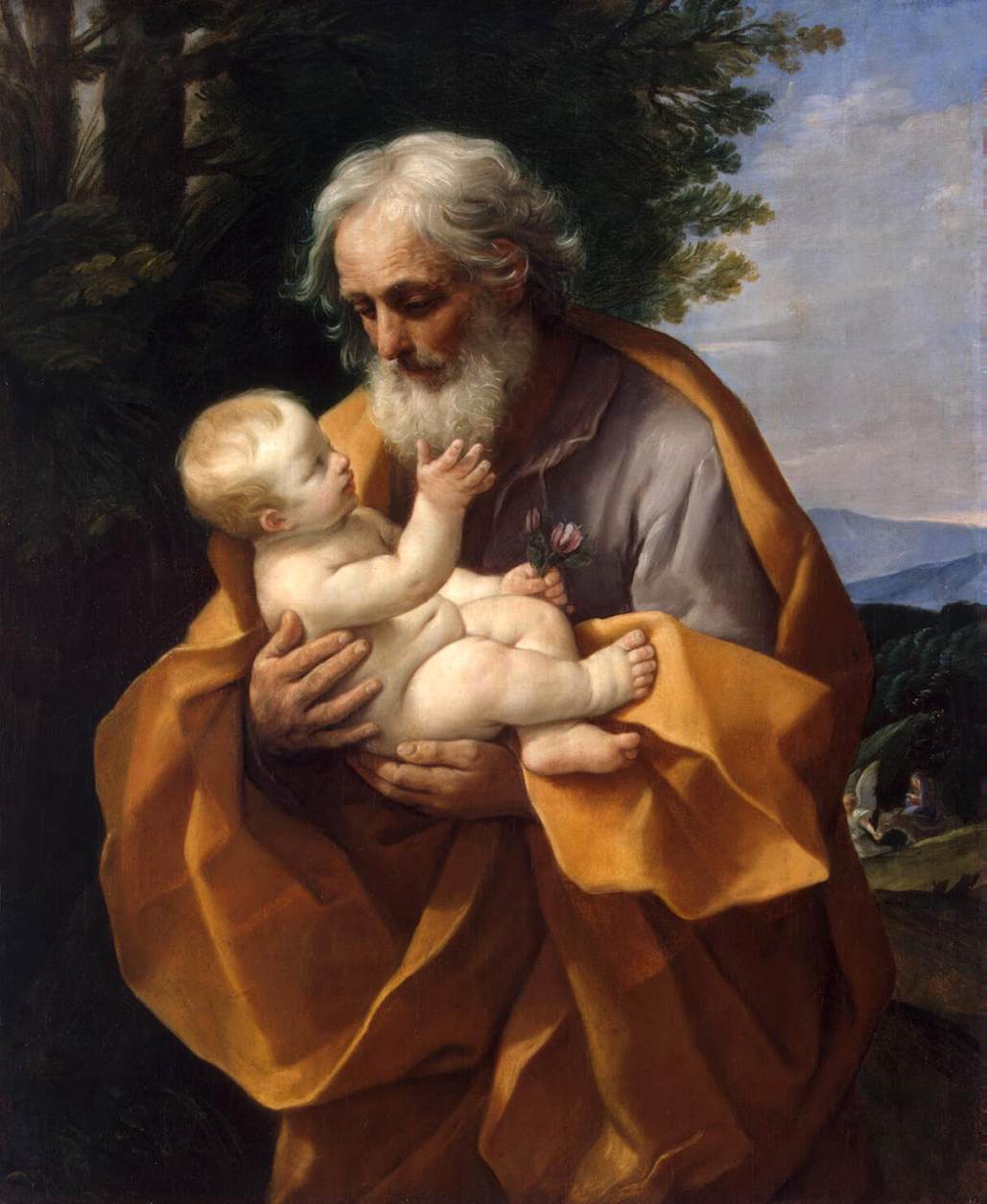
Saint Joseph with the Infant Jesus, Guido Reni (1635, Hermitage Museum)

Joseph with the Child and the Flowering Rod, Alonso Miguel de Tovar
A Commission for a Private Home
It was with great joy that Gabriela received as a commission the realization of a portrait of Saint Joseph holding the Baby Jesus in his arms. She knew the importance of Joseph's role in our history and the impact of such an image in someone's house, which made her even more excited for the task. The Gospels dedicate only a few sentences to Saint Joseph and do not offer us his words. However based on the evangelical references and data from tradition and legends, it is possible to reconstruct the image of the virtuous and loving man who watched over Mary and Jesus and took care of them on earth.
Therefore, Gabriela developed the painting of Saint Joseph with the Child Jesus in oil on a fine linen canvas measuring 55 x 50 cm, in order to be adequately accommodated in its future home. She was partially inspired on a statue of unknown authorship, seeking to portray a young, strong, patient, caring and loving father, fundamental in the development of the human and male personality of the Child Jesus. A deep research was done before starting the composition. Though, beyond the technical part of the painting process, she wanted to dedicate the portrait and the research behind it to all Christians who have been harshly persecuted throughout history and to all the fathers of all times who, with courage and love, played their most noble role, that of guiding and protecting their children, following the example of the just, virtuous, humble and hardworking man, husband and father of the most important family of our history.
The Painting Process
Gabriela developed the painting of Saint Joseph with the Child Jesus following the Old Masters technique. In order to start the painting, she stretched the fine prepared oil linen canvas and applied to its surface a cold medium gray color using a palette knife. This is necessary due to the high value of a white canvas that can disturb the painter’s sense of the relative values of colors applied to it. For the underdrawing layer, Gabriela transferred the composition to the surface of the primed linen using a burnt umber color. In the next day, she did a warm grisaille layer using a mixture of transparent oxide brown and raw umber. She then applied successive dead layers of a mixture of white and raw umber to adjust the form and tone of the face and hands of both Joseph and the Baby Jesus. For the color underpainting layer, she applied broad fields of color in the major areas and turned to the smaller ones using smaller brushes. She worked gradually, day after day, returning to most areas several times to add depth and details after allowing previous coats of color to partially dry. Finally, she did the glazing stage using very thin layers of transparent colors and let the painting dry. After it was completely dried, she applied a thin layer of varnish to protect it from dirt and dust, to revive the colors and even out the painting's final appearance.

Development of Gabriela’s Saint Joseph with the Child Jesus
References
BIBLE. Portuguese. Holy Bible. Translation of the originals using the version of the Monks of Maredsous (Belgium) by the Catholic Biblical Center. São Paulo: AVE MARIA, 1982. Claretian Edition.
Saint Joseph. In Wikipedia. Available at: https://en.wikipedia.org/wiki/Saint_Joseph
Learning from Joseph the Betrothed About Answering Unexpected Callings: Homily for the Sunday After the Nativity of Christ in the Orthodox Church. Eastern Christian Insights, 2012-2021, Fr. Philip LeMasters. Available at: https://blogs.ancientfaith.com/easternchristianinsights/2020/12/26/learning-from-joseph-the-betrothed-about-unexpected-callings-homily-for-the-proto-martyr-stephen-the-archdeacon-and-sunday-after-the-nativity-of-christ-and-commemoration-of-joseph-the-betrothed-da/
Apocrypha: Joseph the Carpenter. Interfaith, 2003-2021. Available at: https://www.interfaith.org/christianity/apocrypha-joseph-the-carpenter/
The Protoevangelium of James. Available at: https://www.asu.edu/courses/rel376/total-readings/james.pdf
IL Vangelo secondo Matteo. Directed by Pier Paolo Pasolini. Italy/ France: Arco Film (Rome)/ Lux Compagnie Cinématographique de France (Paris), 1964. 1 DVD (137 min.).

